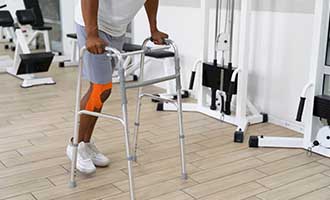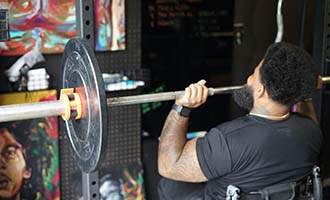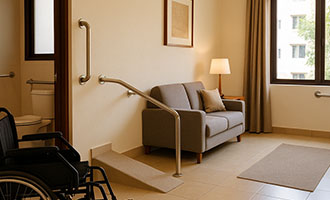Enhancing Sleep Quality for Wheelchair Users
Practical tips and strategies to create a comfortable sleep environment, establish a consistent routine, and address common sleep issues for better rest and well-being.

Quality sleep is vital for everyone, but for wheelchair users, achieving restful sleep can sometimes be a challenge. Factors like discomfort, limited mobility, and certain health conditions can disrupt sleep patterns. However, by implementing some effective strategies, wheelchair users can significantly improve their sleep quality and wake up feeling refreshed. Here are practical tips to enhance your sleep experience.
1. Create a Comfortable Sleep Environment
The foundation of good sleep lies in a comfortable environment. For wheelchair users, this means paying attention to bedding, temperature, and noise levels.
Choose the Right Mattress and Pillows: A supportive mattress is essential for comfort and pressure relief. Consider investing in a memory foam or specialized mattress designed to prevent pressure sores. Additionally, use pillows to support your head, neck, and limbs, helping to maintain proper alignment and reduce discomfort.
Control Room Temperature: Keeping your bedroom cool can promote better sleep. Most people sleep best in a cooler environment, so consider adjusting the thermostat, using a fan, or opting for breathable bedding materials.
Minimize Noise and Light: A quiet, dark room encourages restful sleep. Use blackout curtains to block out light and consider earplugs or a white noise machine to drown out any disruptive sounds.
2. Establish a Consistent Sleep Routine
Having a consistent sleep routine helps regulate your internal clock, making it easier to fall asleep and wake up at the same time each day.
Set a Regular Sleep Schedule: Try to go to bed and wake up at the same time every day, even on weekends. This consistency reinforces your body’s natural sleep-wake cycle.
Develop a Bedtime Ritual: Engage in relaxing activities before bed to signal your body that it’s time to wind down. This could include reading, listening to calming music, or practicing deep breathing exercises.
Limit Naps: While short naps can be refreshing, long or irregular daytime naps can interfere with nighttime sleep. If you need to nap, keep it to 20-30 minutes in the early afternoon.
3. Address Common Sleep Issues
Wheelchair users may face unique sleep challenges, such as pain, muscle spasms, or difficulty finding a comfortable position. Tackling these issues can greatly enhance sleep quality.
Pain Management: If pain disrupts your sleep, consult a healthcare provider to explore pain management options. This may include medication, physical therapy, or adaptive equipment designed to minimize discomfort at night.
Muscle Spasms and Restlessness: If muscle spasms or restless legs disrupt your sleep, try stretching exercises before bed, enjoy a warm bath, or use specialized leg supports to alleviate these symptoms.
Positioning Support: Maintaining a comfortable sleeping position is key to preventing pressure sores. Use positioning aids, like body pillows or wedges, to help distribute weight evenly and relieve pressure on vulnerable areas.
4. Promote Relaxation and Reduce Stress
Stress and anxiety can hinder your ability to fall asleep and stay asleep. Incorporating relaxation techniques into your bedtime routine can foster a more peaceful night’s sleep.
Practice Mindfulness or Meditation: Spend a few minutes focusing on your breath or engaging in guided meditation before bed to calm your mind and reduce stress.
Try Progressive Muscle Relaxation: This technique involves tensing and then slowly relaxing each muscle group in your body, helping to release physical tension and prepare for sleep.
Limit Stimulants: Avoid caffeine, nicotine, and heavy meals close to bedtime, as these can interfere with your ability to fall asleep.
5. Seek Professional Help for Sleep Disorders
If sleep issues persist despite trying these strategies, it may be time to seek professional guidance. Sleep disorders like sleep apnea, insomnia, or restless legs syndrome are treatable with the right support.
Consult a Sleep Specialist: A sleep specialist can evaluate your sleep patterns and recommend effective treatments, such as cognitive behavioral therapy for insomnia (CBT-I) or other tailored interventions.
Consider Adaptive Devices: Some wheelchair users may benefit from specialized beds or adjustable pillows that enhance comfort and support better sleep.
Conclusion
Improving sleep quality is crucial for the overall health and well-being of wheelchair users. By creating a comfortable sleep environment, establishing a consistent routine, addressing common sleep issues, and promoting relaxation, you can achieve more restful and rejuvenating sleep. If sleep problems persist, don’t hesitate to seek professional help—taking that step can lead to a better quality of life. Sweet dreams!
Related
-

Tips to Choose the Right Physical Therapist for Your Needs
-

Adaptive Fitness: Exercise Tips for Individuals with Limited Mobility
-

Beginners, chair cardio is the way to go!
-

The Importance of Wheelchair Assistance for the Elderly
-

Best Wheelchairs for Senior Citizens in Mumbai Buyers Guide
-

How to Choose Reliable Mobility Services at Home in Mumbai
-

Beyond the Wheelchair: Why Emotional Support Is Just As Important As Physical Help
-

Understanding Spina Bifida: Symptoms, Types, and Early Detection
-

Benefits of Hiring a Companion for Elderly Care in Mumbai
-

Understanding the Benefits of In-Home Elder Care for Loved Ones
-

Embracing Holistic Wellness: A Guide for Seniors and Individuals with Mobility Needs
-

The Ultimate Guide to Choose the Right Walking Devices for Adults
-

Physiotherapy tips for home
-

Fashion Forward: Style Tips for People with Limited Mobility
-

Innovative Walking Assistance Devices for Adults
-

Best Elderly Care Apps for Seniors in 2025
-

Dating with a Disability: Navigating Love, Relationships, and Mobility Challenges
-

Choosing the Right Care Taker Services in Mumbai for Your Needs
-

Finding the Perfect Health Service Provider: Tips for Elderly Care
-

Sports Injury Prevention Strategies for Mumbais Active Youth
-

Breathing right can change your life
-

How to Help People with Disabilities: A Guide to Inclusive Practices
-

How Sport Rehabilitation in Mumbai Helps Athletes Bounce Back Stronger
-

Tips To Empower People with Limited Mobility
-

Rolling Towards Peace
-

Focus your mind to stay healthy
-

Slippery Roads Ahead: How to Keep Elderly Loved Ones Safe This Monsoon
-

Top Benefits of Visiting a Physical Therapy Clinic
-

Wheels of Support
-

Best Physical Therapies in Mumbai for Post-Operative Recovery
-

Top Qualities to Look for in Elderly Carers in Mumbai
-

Rollin' in the Greens.
-

Why Routine Health Check-Ups Matter for Wheelchair Users
-

Rolling Through the Rain: A Monsoon Safety Guide for Wheelchair Users
-

The Role of Hydration in Health and Wellness
-

Stay in shape with Yoga
-

In-Home Health Care Services in Mumbai Using the MobiCrew App
-

Get in the game
-

How to Choose the Right Sports Rehab Treatment Clinic Near You
-

How Accessible Homes Create Truly Independent Living
-

The power of Pilates









